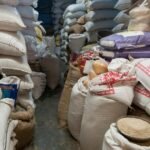OVERVIEW
The market for beneficial insects (macrobials) projected to reach USD 945.47 million by 2024, rising over the forecast period at a CAGR of 9.56%. With the rising demand for food security for the growing population, together with the world’s limited agricultural land, increased crop loss due to various pest problems, and increased demand for organic food products, the use of beneficial insects (macrobials) is expected to fuel market growth.








TABLE OF CONTENT
1 Global Beneficial Insects (Macrobials) Market
1.1 Study Objectives
1.2 Market Definition
1.3 Study Scope
1.3.1 Markets Covered
1.3.2 Geographic Scope
2 RESEARCH METHODOLOGY
2.1 Research Data
2.1.1 Secondary Data
2.1.1.1 Key Data From Secondary Sources
2.1.2 Primary Data
2.1.2.1 Key Data From Primary Sources
2.1.2.2 Key Industry Insights
2.1.2.3 Breakdown of Primaries
2.2 Market Size Estimation
2.2.1 Bottom-Up Approach
2.2.2 Top-Down Approach
2.3 Market Breakdown and Data Triangulation
2.4 Research Assumptions
3 Global Beneficial Insects (Macrobials) Market – Executive Summary
3.1 Market Revenue, Market Size and Key Trends by Company
3.2 Key Trends by type of Application
3.3 Key Trends segmented by Geography
4 Global Beneficial Insects (Macrobials) Market – Comparative Analysis
4.1 Product Benchmarking – Top 10 companies
4.2 Top 5 Financials Analysis
4.3 Market Value split by Top 10 companies
4.4 Patent Analysis – Top 10 companies
4.5 Pricing Analysis
5 Global Beneficial Insects (Macrobials) Market – Industry Market Entry Scenario
5.1 Regulatory Framework Overview
5.2 New Business and Ease of Doing business index
5.3 Case studies of successful ventures
5.4 Customer Analysis – Top 10 companies
6 Global Beneficial Insects (Macrobials) Market – Market Forces
6.1 Introduction
6.2 Market Dynamics
6.2.1 Drivers
6.2.2 Opportunities
6.2.3 Challenges
6.3 Porters Analysis of Market
6.3.1 Bargaining power of suppliers
6.3.2 Bargaining powers of customers
6.3.3 Threat of new entrants
6.3.4 Rivalry among existing players
6.3.5 Threat of substitutes
7 Global Beneficial Insects (Macrobials) Market – Strategic Analysis
7.1 Value Chain analysis
7.2 Product Life Cycle
7.3 Supplier and distributor analysis (Market share and product dealing strategies)
8 Global Beneficial Insects (Macrobials) Market – By Type (Market Size – & million/billion)
8.1 Predators
8.2 Parasitoids
8.3 Pathogens
8.4 Pollinators
9 Global Beneficial Insects (Macrobials) Market – By Application
9.1 Crop protection
9.2 Crop production
10 Global Beneficial Insects (Macrobials) Market – By Geography (Market Size – &million/billion)
10.1 Introduction
10.2 North America
10.2.1 US
10.2.2 Canada
10.2.3 Mexico
10.3 Europe
10.3.1 U.K
10.3.2 Germany
10.3.3 Italy
10.3.4 France
10.3.5 Spain
10.3.6 Rest of Europe
10.4 Asia-Pacific
10.4.1 China
10.4.2 Japan
10.4.3 India
10.4.4 South Korea
10.4.5 Rest of APAC
10.5 Rest of the World
10.5.1 South America
10.5.2 Middle East
10.5.3 Africa
11 Global Beneficial Insects (Macrobials) Market – Entropy
11.1 New product launches
11.2 M&A’s, collaborations, JVs and partnerships
12 Global Beneficial Insects (Macrobials) Market Company Profile (Key Players)
12.1 Market Share, Company Revenue, Products, M&A, Developments
12.2 Applied Bio-Nomics Ltd.
12.3 Biobest NV
12.4 Bioline Agrosciences Ltd.
12.5 Fargro Ltd.
12.6 Andermatt Biocontrol AG
12.7 Arbico Organics
12.8 Biobee Biological Systems Ltd.
12.9 Biological Services
12.10 Dudutech
12.11 Natural Insect Control
12.12 Company 11 & more
13 Global Beneficial Insects (Macrobials) Market – Appendix
13.1 Sources
13.2 Abbreviations













